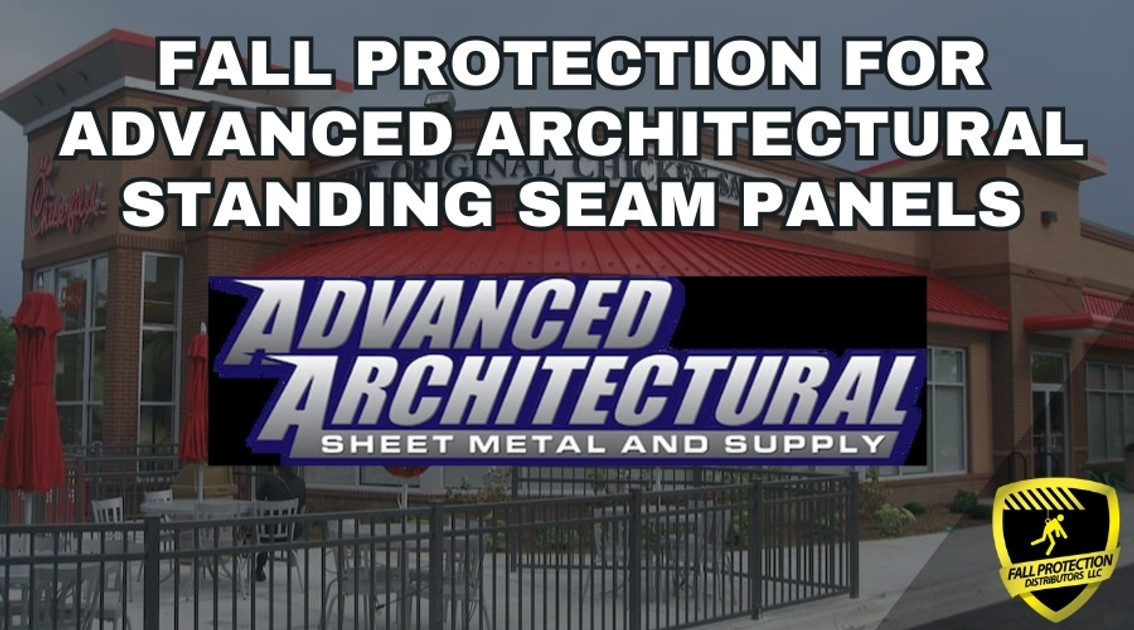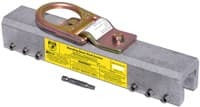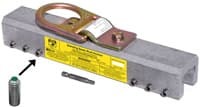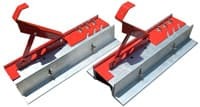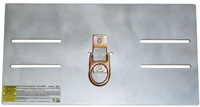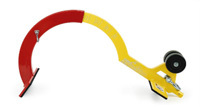Fall Protection Strategies For Advanced Architectural Roofs
Posted by Howie Scarboro - CEO Fall Protection Distributors, LLC on Jan 17th 2025
See the Roof Anchor Compatibility Chart for Advanced Architectural Sheet Metal Standing Seam Metal Roofing.

Who Is Advanced Architectural Sheet Metal?
Advanced Architectural Sheet Metal takes a hands-on approach to delivering exceptional products to the roofing and metal building industry. Based on a commitment to quality and personalized service, their mission is simple yet powerful: provide small to medium-sized contractors with architectural sheet metal solutions, gutters, and rain accessories that meet the highest standards while remaining affordable.
This Michigan-based manufacturer offers a product line that caters to contractors looking to reduce overhead and save time. With over 98% of its offerings made-to-order and crafted in-house, Advanced Architectural has built its reputation on precision, reliability, and flexibility.
Advanced Architectural Sheet Metal prioritizes customer relationships, understanding that personalized service and consistent quality are as important as competitive pricing. Contractors nationwide trust them for the expertise and care that go into every order.

Why Are Compatible Fall Protection Anchors Critical For Advanced SnapLock Panels?
SnapLock panels are a marvel of engineering, combining sleek aesthetics with structural efficiency. But while their interlocking design makes them a go-to choice for roofing professionals, it also demands a specialized approach to fall protection. Working on these panels without proper anchorage is like balancing on a tightrope during a windstorm—risky and nerve-wracking. See the Roof Anchor Compatibility Chart for Advanced Architectural Sheet Metal SnapLock Standing Seam Metal Roofing.
Using compatible fall protection anchors is crucial for preserving the integrity of SnapLock panels. Non-penetrating anchors, designed to clamp securely onto the seams without drilling, ensure the roof's waterproofing and structural integrity remain intact. Advanced SnapLock panels rely on precise interlocking mechanisms to function, so even a small error in anchor placement can lead to compromised seams and potential warranty issues.
Investing in tailored fall protection systems is a matter of safety and reputation for contractors. A roof that leaks due to improper anchorage is a costly mistake no one wants to face. Compatible systems keep workers safe and protect the roof from avoidable damage. This approach ensures that every project, whether a sprawling commercial roof or a sleek residential design, is completed with confidence and peace of mind. After all, the best roofs perform perfectly under pressure in the weather and during installation.
Fall Protection For Snap Lock Panels: A Closer Look at SSRA Products

When working on 24-gauge Snap Lock Panels, fall protection must balance worker safety and preserve the roofing system's integrity. The SSRA1 Seam Anchor, SSRA2 Adjustable Roof Jack, and SSRA3 Anchor Plate work seamlessly together to provide a non-penetrating, reliable solution for securing workers while maintaining the panels' structural and aesthetic qualities. Let's explore how each product functions, its benefits, and how they complement one another to create a comprehensive fall protection system.
SSRA1 Seam Anchor: A Versatile Foundation
The SSRA1 Seam Anchor is the cornerstone of the SSRA fall protection system. This non-penetrating anchor clamps securely onto the Snap Lock Panel's seams without drilling or puncturing, preserving the roof's watertight design. Made from lightweight yet durable aluminum and stainless steel components, the SSRA1 is easy to install and resistant to corrosion, making it suitable for long-term use in various environmental conditions.
How It's Used:
The SSRA1 clamps directly onto the standing seam, creating a secure attachment point for fall protection equipment. It is a base for attaching lanyards, lifelines, or other fall arrest systems. Its universal compatibility with most standing seam profiles ensures compatibility across multiple projects.
Benefits:
Non-penetrating design: Protects the roof from leaks and damage.
Quick installation: Saves time on job sites.
Durable construction: Withstands harsh conditions and ensures long-term reliability.
Versatility: Can be used independently or in combination with other SSRA products.
SSRA2 Adjustable Roof Jack: Enhancing Stability
The SSRA2 Adjustable Roof Jack builds on the functionality of the SSRA1 by providing a platform for attaching walkboards. This feature is handy for creating stable, level surfaces on sloped roofs, making it easier for workers to navigate the job site safely and efficiently.
How It's Used:
The SSRA2 attaches to the SSRA1 Seam Anchor, allowing contractors to mount walk boards securely across the roof. The adjustable design accommodates various roof pitches, ensuring a stable work surface regardless of slope.
Benefits:
Increased stability: Supports walk boards to provide workers with a secure footing.
Adjustable design: Adapts to different roof slopes for greater versatility.
Time-saving setup: Reduces the need for makeshift platforms or additional scaffolding.
Enhanced safety: Minimizes the risk of slips and falls on steep or slippery surfaces.
SSRA3 Anchor Plate: Extending Safety with Horizontal Lifelines
The SSRA3 Anchor Plate attaches to the SSRA1 Seam Anchor, creating a tie-off point for temporary horizontal lifelines. This setup is ideal for projects requiring multiple workers to move safely along the roof while maintaining 100% tie-off compliance.
How It's Used:
The SSRA3 mounts on top of the SSRA1 Seam Anchor, forming a secure anchor point for horizontal lifeline systems. These systems allow workers to traverse the roof while remaining connected to a safety line, reducing the risk of falls and ensuring OSHA compliance.
Benefits:
Enhanced mobility: Allows workers to move freely along the roof without disconnecting and reconnecting their safety gear.
Increased productivity: Reduces downtime associated with relocating anchor points.
Versatile compatibility: Works seamlessly with various fall arrest and fall restraint systems.
Comprehensive protection: Ensures multiple workers can operate safely within the same zone.
How These Products Work Together
The SSRA1, SSRA2, and SSRA3 create a cohesive fall protection system tailored for Snap Lock Panels. The SSRA1 provides the foundation, clamping securely to the roof seams without damage. The SSRA2 expands the system's functionality by supporting walk boards, offering a stable platform for workers to perform tasks safely. The SSRA3 completes the system by facilitating temporary horizontal lifelines, ensuring continuous tie-off for multiple workers.
Key Benefits of the System as a Whole:
Non-penetrating design: Preserves the roof's structural and watertight integrity.
Customizable configurations: Adapts to the unique needs of each job site.
Enhanced safety: Offers comprehensive fall protection for workers at various points on the roof.
Ease of use: Streamlines setup and operation, saving valuable time on the job.
Conclusion:
The SSRA system is a game-changer for contractors working on standing seam roofs like Snap Lock Panels. By combining the SSRA1 Seam Anchor, SSRA2 Adjustable Roof Jack, and SSRA3 Anchor Plate, contractors can ensure worker safety, maintain the roof's integrity, and enhance productivity. Investing in quality, safety, and efficiency delivers peace of mind for workers and project managers.
Batten Cap U-Panels: The Perfect Blend of Style and Simplicity

Batten Cap U-Panels offer a sleek, versatile solution for functional and aesthetic roofing needs. Their innovative design eliminates the confusion of orientation—there is no left or right, top or bottom—making installation fast and straightforward. This time-saving feature is a favorite among contractors who value efficiency without sacrificing quality.
The panels feature a distinctive double hem standing seam batten cap that locks securely into place. This concealed clip fastening system ensures durability and enhances the roof's visual appeal. The narrow, low-profile snap-on batten creates a clean, streamlined appearance, allowing architects and designers to incorporate high-profile or radius features into their projects.
These panels are 24-gauge steel with a durable Kynar finish, with options for a 1-inch or 1.5-inch leg height. Optional flat rib stiffeners add extra structural integrity, making Batten Cap U-Panels a dependable choice for long-term performance and aesthetic excellence.
Fall Protection For Batten Cap U-Panels
The unique design of Batten Cap U-Panels, particularly the batten cover, presents specific challenges for fall protection. Traditional seam-mounted systems like SSRA products are incompatible due to the shape and functionality of the batten cap. However, worker safety and roof integrity remain paramount. See the Roof Anchor Compatibility Chart for Advanced Architectural Sheet Metal Batten Cap U-Panel Standing Seam Metal Roofing.
The Ridge Pro Steep Assist Anchor is the optimal solution for maintaining safety on 6/12 to 12/12 pitch roofs featuring Batten Cap U-Panels. This non-penetrating anchor securely hooks over the roof's peak, creating a reliable worker tie-off point. The Ridge Pro Steep Assist preserves the roof's structural and waterproof qualities and fully complies with safety regulations.
Lightweight and portable, the Ridge Pro Steep Assist Anchor is easy to transport and set up, saving valuable time on busy job sites. Its design ensures workers can confidently navigate steep slopes while protecting against falls.
Why Choose the Ridge Pro Steep Assist for Batten Cap U-Panels?
Non-penetrating design: Protects the roof's integrity by eliminating the need for drilling or puncturing.
Reliable tie-off point: Keeps workers safe on steep or challenging roof slopes.
Quick setup: Saves time and reduces delays during installation or maintenance projects.
Portable and lightweight: Enhances mobility on job sites without compromising durability.
When working with Batten Cap U-Panels, it's essential to prioritize worker safety and preserve the roof's unique design. The Ridge Pro Steep Assist Anchor offers the perfect balance, ensuring your project runs smoothly and safely from start to finish.
Standing Seam Roof Anchor Point Compatibility for Advanced Architectural Sheet Metal
| Batten Cap U-Panel 22-26 ga. |
Snap Lock Panel 22-24 ga. |
|
|---|---|---|
| NO | YES | |
| NO | YES | |
| NO | YES | |
| NO | YES | |
| YES | YES |
Contact Us For More Information
For further details on roofing solutions and fall protection systems, contact us at 863-703-4522 or www.StandingSeamRoofAnchor.com. Let's work together to make your roofing projects safe, beautiful, and built to last. For more safety tips, check out OSHA's 48-page fall protection manual. Once you have determined the most suitable anchors for your roof system, download our free Anchor Inspection Form.
Safety Tips For Standing Seam Roofs
Set Up Protective Guardrail Barriers for Work Zones
Defining work zones with guardrails or warning lines enhances safety by clearly marking hazardous edges. These barriers provide an extra layer of protection, especially on expansive or low-slope roofs, ensuring workers stay focused and safe. Thoughtful placement minimizes distractions and keeps workers securely within safe boundaries.
Equip Workers with High-Quality Safety Gear
Providing workers with top-tier safety gear lays the foundation for a secure work environment. OSHA-approved harnesses, lanyards, and fall arrest systems should fit comfortably and function reliably. High-quality equipment instills confidence in workers, encourages consistent use, and significantly reduces the risk of workplace accidents.
Encourage the Use of Trauma Straps
Trauma straps are life-saving tools that prevent circulation issues during fall incidents. Equip workers with these essential devices and provide thorough training on their use. When deployed effectively, trauma straps alleviate leg pressure and improve rescue outcomes, safeguarding worker health during emergencies.
Ensure Proper Footwear for Stability
Roofing tasks demand durable, slip-resistant footwear that enhances stability on metal surfaces. Properly designed shoes improve traction, particularly on wet, icy, or steep roofs, reducing the likelihood of slips. Ensuring workers have the proper footwear boosts their confidence and promotes safe, efficient movement.
Develop OSHA-Compliant Safety Plans
A robust safety plan tailored to OSHA standards is critical for roofing projects. It should include detailed fall prevention measures, emergency response protocols, and rescue strategies. Comprehensive planning protects workers, ensures compliance, and fosters a well-organized, secure job site.
Use Specialized Anchor Systems for Standing Seam Roofs
Standing seam roofs require non-penetrating, clamp-on anchors that safeguard workers and roof integrity. These systems secure firmly to seams without drilling, preserving the roof's watertight design. Avoid anchors that require locating hidden panel clips, as improper installation can jeopardize safety and performance.
Consult Experts for Curved Metal Panels
Curved roofs present unique challenges that demand expert input. Consulting with safety professionals ensures the correct fall protection systems are selected and installed. Expert guidance protects workers and preserves the roof's structural and aesthetic integrity, addressing the specific demands of curved panels.
Promote a Culture of Safety
Creating a safety-focused work culture reduces risks and strengthens teamwork. Open discussions about potential hazards, regular safety briefings, and an easy reporting system for dangers encourage proactive behavior. A unified commitment to safety minimizes accidents and boosts workplace efficiency.
Install Permanent Roof Anchor Systems
Permanent anchors offer an effective, long-term safety solution for roofs requiring frequent maintenance. These systems provide a consistent tie-off point, reducing setup time and ensuring compliance. High-traffic commercial roofs benefit greatly from the convenience and reliability of permanent anchor systems.
Prioritize Ladder Safety Training
Proper ladder use is vital for safe roof access. Train workers to position ladders on stable ground and follow the 4-to-1 ratio for base-to-height placement. Emphasizing secure ladder setup minimizes accidents, ensuring smooth and safe transitions to and from the roof.
Disclaimer
The views, recommendations, and information presented in this blog are solely those of the author and do not necessarily reflect the opinions or positions of the featured panel manufacturer, its brands, subsidiaries, or parent companies. Customers are strongly encouraged to reach out directly to the roof panel manufacturer for inquiries regarding fall protection compatibility with their products and to address any potential warranty issues that may arise following the installation of our products.

